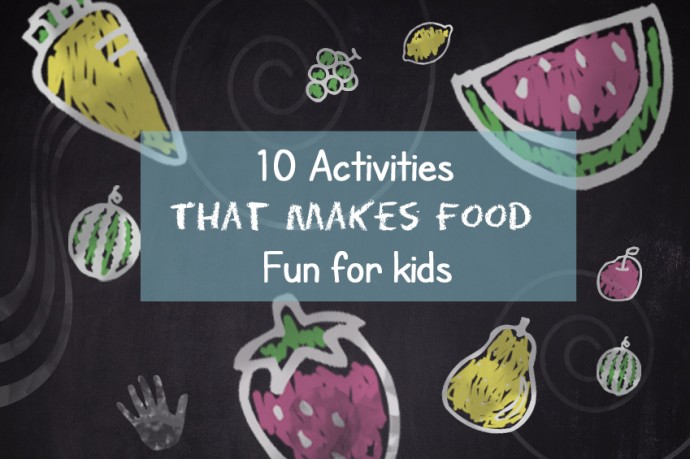When wanting to eat healthy, you can sometimes put too much importance on the nutritional value of food. Of course, your intentions are good, but to only consider calories and portion sizes can leave you disenchanted!
For kids, healthy food activities must focus on the pleasure associated with discovering new food using the senses and where it comes from, more than its nutritional value and effects on health.
Childhood is the ideal time to stimulate sensory perception since it’s a time of curiosity and discovery in terms of food. To make food fun for kids, here are 10 fun activities that use sight, touch, smell, taste and sound. These activities are for kids between 5 and 11 years old, but can be simplified for younger kids (3 to 4 years) or made a little more complex for kids 11 years or older.
1. Describe like a chef
Have fun describing food using only your eyes. Can you describe the colour, shape and texture? Is it red like a raspberry or green like a pepper? Is it round or triangular? Is it grainy, smooth or soft? Does it look appetizing? This activity will help you recognize your food preferences and name them.
2. Notice the variety of fruits and veggies
Whether at the grocery store or at home, try to spot weird shaped veggies; in other words, the ones that don’t have a standard shape and that are considered deformed. Try to identify the differences and what they make you think of. For example, a carrot with two “legs” can become a carrot that can run! In some ways, it’s just the physical diversity of vegetables. It’s normal for there to be variations between them, just like people.
3. Create a work of art in your plate

Some dishes have to be put together, like pizza, wraps and tortillas. When all the ingredients are prepared, tomatoes cut, lettuce chopped or cheese grated, ask the kids to create a work of art in their plates with the ingredients at their disposal. Once the plates are assembled, ask them if they see any differences or similarities.
4. Draw a fruit or vegetable that is in season
When you’re at the grocery store, ask the child to choose a fruit or vegetable that’s local and/or in season. Buy or take a picture of it. Once you’re back home, ask them to draw the fruit or vegetable and write their name, season and/or where it came from on it. This activity will make them aware of seasonal fruits and vegetables.
5. Touch a mystery food
Blindfold the child and ask them to touch food that they’re familiar with to discover its temperature and texture. You can use a kiwi, carrot, lettuce leaf or anything you have on hand. Is it cold or warm? Is it mushy, firm or soft? Using only hands and without looking, ask them if they recognize the mystery food.
6. Smell hidden food
Use a dozen small, opaque jars like spice jars. In each one, hide familiar food in it. You can use vanilla, mint, coffee or whatever else is in your pantry. Cover the food with a paper towel so the child can’t see it. Using only their nose, ask the child to smell each pot and try to guess what the hidden food is.
7. Taste food without breathing
Food doesn’t taste like anything when you have a cold, but it’s more your sense of smell that’s affected. A fine layer of mucus covers your olfactory receptors found deep in the nose which prevents you from smelling food. To imitate the effects of a cold, ask the child to put food in their mouth, then pinch their nose for a few seconds while chewing. What does it taste like? What about when the nose isn’t pinched?
8. Taste with different parts of the tongue
The tongue has several kinds of taste buds, but precise zones to detect sweet, salty, acidic and bitter is a myth. There are many reasons that each person perceives taste differently. When a child has food in their mouth, ask them to try tasting it on different places on their tongue. What are the different tastes?
9. Discover new food

The next time you go to the grocery store, ask the child to choose a fruit, vegetable or other food that they don’t know. Then once back home, make a tasting sheet to take notes. With the child, write down the name of the food, then taste it using sight, touch, smell, taste and sound. What is the food’s overall satisfaction and why?
10. Listen to sounds in the kitchen
When making a meal, ask the child to try and imitate the sounds in the kitchen. For example, pay particular attention to sounds when husking corn, pouring a fizzy drink or chewing a piece of cheese. Then, invite the child to name verbs that define the sounds. Was it crispy, fizzy or crunchy?
These 10 activities make food entertaining for kids and help them gain knowledge by focusing on fun and games. Discovering food with the five senses even encourages kids to try new food. The more they taste, the greater the chance they’ll like it.
Download the factsheets of our 10 activities here to do it with a child or a group of kids !
Outside the home, the organization The Rainbow Plate offers a taste adventurers program that helps kids discover a variety of food and pique their curiosity from garden to kitchen. Far from being a numbers thing, eating healthy is also about learning to garden, doing groceries, cooking, gathering around the table, sharing, tasting and having fun!
What do you to get your kids excited about food?










